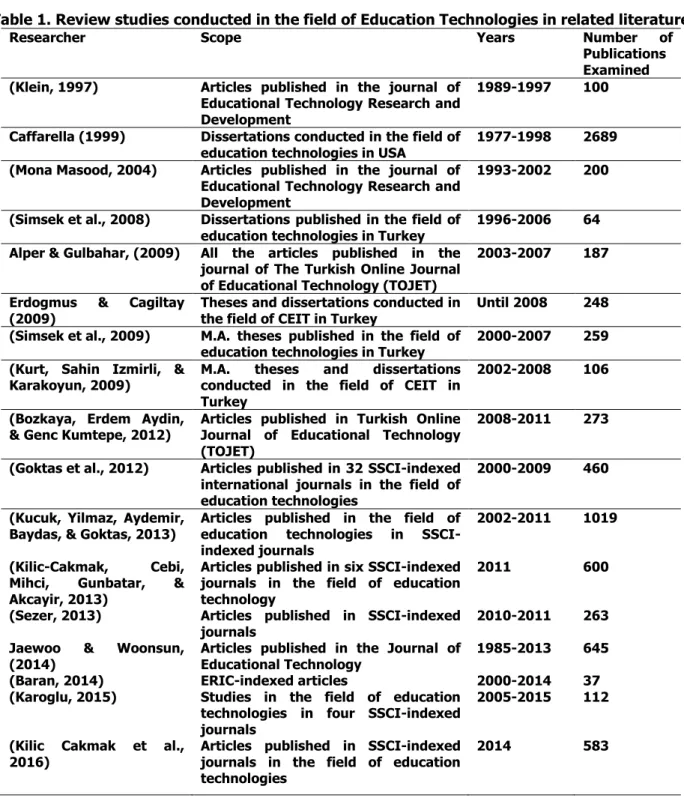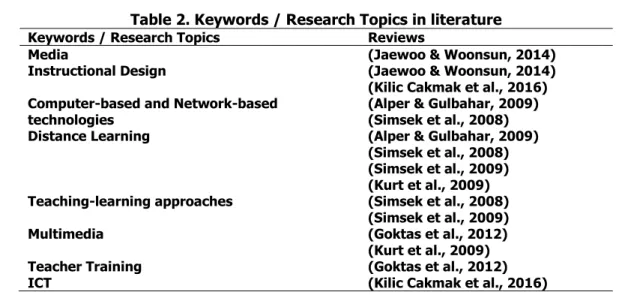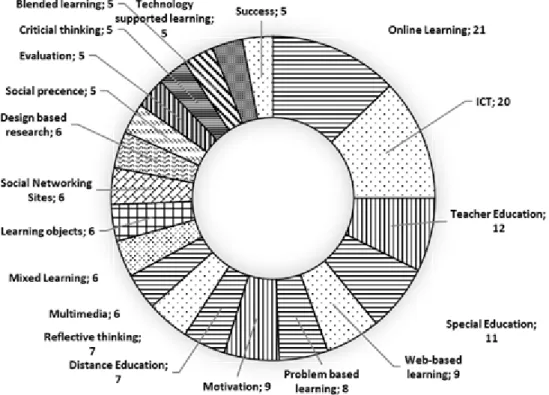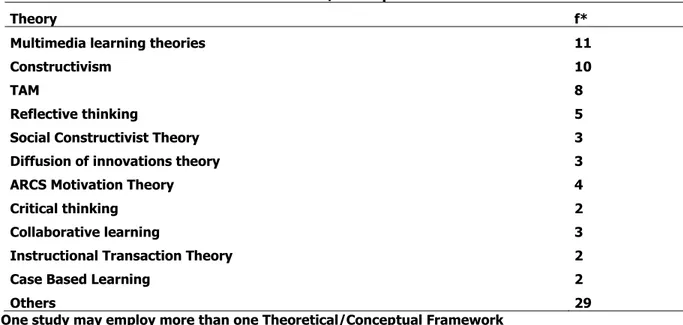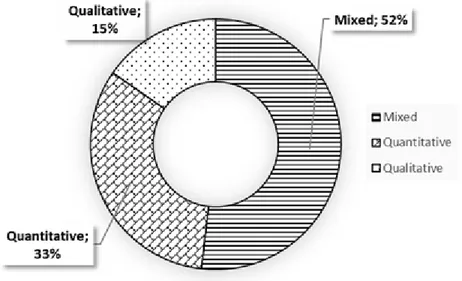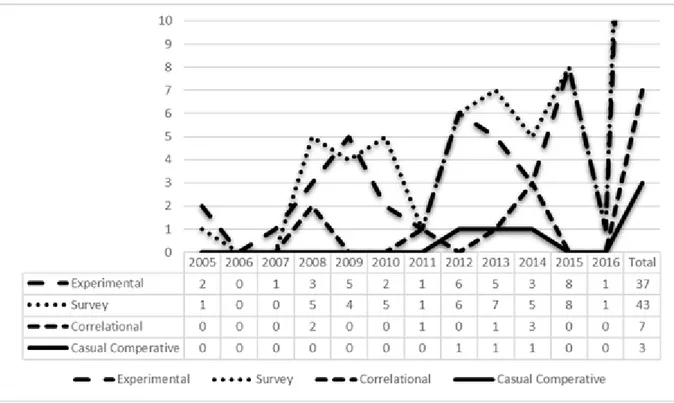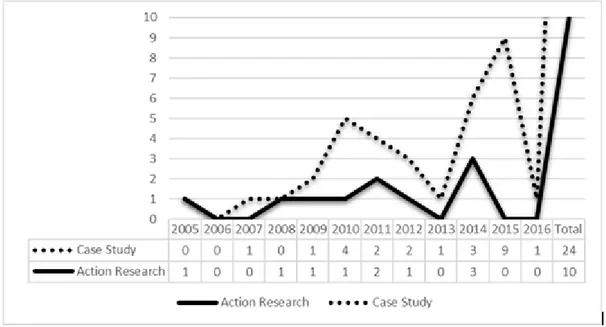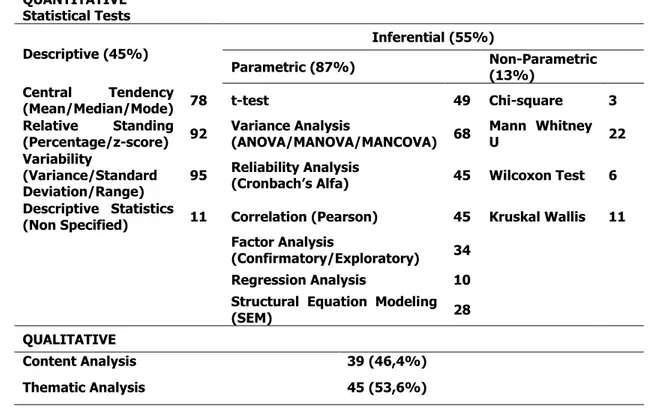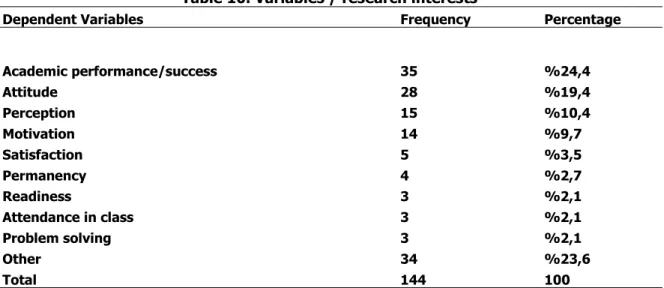128 Turkish Online Journal of Distance Education-TOJDE April 2018 ISSN 1302-6488 Volume: 19 Number: 2 Article 10
A CONTENT ANALYSIS OF DISSERTATIONS IN THE FIELD OF
EDUCATIONAL TECHNOLOGY: THE CASE OF TURKEY
Dr. Gurhan DURAK Computer Education and Instructional Technology Department Balıkesir University Balıkesir, Turkey Dr. Serkan CANKAYA Computer Education and Instructional Technology Department Balıkesir University Balıkesir, Turkey Dr. Eyup YUNKUL Computer Education and Instructional Technology Department Balıkesir University Balıkesir, Turkey Dr. Zeynel Abidin MISIRLI Computer Education and Instructional Technology Department Balıkesir University Balıkesir, Turkey ABSTRACT
The present study aimed at conducting content analysis on dissertations carried out so far in the field of Educational Technology in Turkey. A total of 137 dissertations were examined to determine the key words, academic discipline, research areas, theoretical frameworks, research designs and models, statistical analyses, data collection tools, participants, instructional design models, variables/research focus and related institutions. When the research results were examined, it was found in relation to the dissertations that the most frequent method was “mixed method”; that the most frequent data collection tools were “interview”, “questionnaire” and “scale”; that the participants were generally “university students”; that the dependent variables were “attitude” and “achievement”; that the most frequent data analysis method was “parametric analysis”; and that the field of “education and training” was the one most frequently investigated. Among the most frequent key words was Online Learning, which was followed by Information and Communication Technology (ICT), Teacher Training and Special Education. In this respect, the present study, which examined dissertations, is thought to be important since it tried to reveal the current state of educational technologies in Turkey and to determine the related research trends.
Keywords: Content analysis, educational technology, ICT, online learning. INTRODUCTION
Educational technologies could be regarded as a field which has a long history. Especially after 1990s, with the rapid development of information and communication technologies, this field developed a lot and became a research subject of a number of studies (Alamin,
129 Shaoqing & Le, 2015; Alper & Gulbahar, 2009; Hart & Laher, 2015; Nye, 2015). In related literature, it is seen that the concepts of educational technologies and instructional technologies are used interchangeably and that several definitions of the concepts were provided (Lakhana, 2014). In the world, Association for Educational Communications and Technology (AECT), which has the oldest and most important place in relation to this subject (Lakhana, 2012), defines educational technology as an appropriate technological process, facilitating learning by using and creating sources and increasing the performance (Januszewski & Molenda, 2008). The concept of educational technologies is quite a general concept. Such concepts as computer-aided instruction, computer-based instruction, e-learning, mobile e-learning, web-based teaching, Information and Communication Technologies (ICT) in education, learning technologies, multimedia learning and online learning could all be said to belong to the field of educational technologies. In this respect, in related literature, compilation studies which included these concepts were examined.
It could be stated that the development of the field of educational technology in Turkey started with the establishment of departments of Computer Education and Instructional Technologies (CEIT) in 1998 to train undergraduate students who will become teachers of information technologies at schools belonging to the Ministry of National Education. When the postgraduate curricula of CEIT departments are examined, it is seen that the focus is intensively on educational technologies. Also, even a doctorate program in Hacettepe University in Ankara is called Education Technologies, which is actually executed by the faculty members of the department of CEIT at the university.
It is important for researchers and educators, who are practitioners of education technologies, to follow the academic developments regarding education technologies (Thompson, 2005). However, the high number of studies conducted in this field makes it difficult to recognize the historical development of the field and to follow the current trends. Therefore, it is important to conduct studies which will reveal the historical development of educational technologies and the current trends in the field and which will provide educators, researchers and administrators with insights in the field. Master of Arts studies are generally regarded as studies which allow students to learn research methods. On the other hand, in dissertations, what is more important is significance of the study for the related field and its contribution to the literature. Also, what five academicians forming a dissertation jury focus on most is the contribution of the dissertation to the field. In this respect, dissertations could be said to be quite valuable studies that fill an important gap in related literature. The field of educational technologies is quite a large and comprehensive field, and it is almost impossible to reach the related dissertations throughout the world. In this respect, the sample of Turkey was selected from this large universe, and all the dissertations conducted in Turkey were reached. Therefore, it may not be possible to generalize the results of the present study for the whole world. However, it is thought that the study will provide insights for researchers carrying out studies in the field of educational technologies.
The present study aimed at conducting content analysis on the dissertations carried out so far in the field of educational Technologies and CEIT in Turkey to help people interested in educational technologies become prepared for difficulties likely to be experienced in their studies.
RELATED REVIEW STUDIES IN LITERATURE
In literature, there are a number of review studies conducted in the field of educational technology. Within the scope of the present study, 15 review studies were reached. In most of these studies, which included use of the content analysis method, the articles were examined, and in the rest of them, the theses and dissertations were examined. Table 1
130 presents such data regarding these studies as scope, year and the number of publications examined.
Table 1. Review studies conducted in the field of Education Technologies in related literature
Researcher Scope Years Number of Publications Examined (Klein, 1997) Articles published in the journal of
Educational Technology Research and Development
1989-1997 100 Caffarella (1999) Dissertations conducted in the field of
education technologies in USA 1977-1998 2689 (Mona Masood, 2004) Articles published in the journal of
Educational Technology Research and Development
1993-2002 200 (Simsek et al., 2008) Dissertations published in the field of
education technologies in Turkey 1996-2006 64 Alper & Gulbahar, (2009) All the articles published in the
journal of The Turkish Online Journal of Educational Technology (TOJET)
2003-2007 187 Erdogmus & Cagiltay
(2009) Theses and dissertations conducted in the field of CEIT in Turkey Until 2008 248 (Simsek et al., 2009) M.A. theses published in the field of
education technologies in Turkey 2000-2007 259 (Kurt, Sahin Izmirli, &
Karakoyun, 2009)
M.A. theses and dissertations conducted in the field of CEIT in Turkey
2002-2008 106 (Bozkaya, Erdem Aydin,
& Genc Kumtepe, 2012) Articles published in Turkish Online Journal of Educational Technology (TOJET)
2008-2011 273 (Goktas et al., 2012) Articles published in 32 SSCI-indexed
international journals in the field of education technologies
2000-2009 460 (Kucuk, Yilmaz, Aydemir,
Baydas, & Goktas, 2013)
Articles published in the field of education technologies in SSCI-indexed journals
2002-2011 1019 (Kilic-Cakmak, Cebi,
Mihci, Gunbatar, & Akcayir, 2013)
Articles published in six SSCI-indexed journals in the field of education technology
2011 600 (Sezer, 2013) Articles published in SSCI-indexed
journals 2010-2011 263 Jaewoo & Woonsun,
(2014) Articles published in the Journal of Educational Technology 1985-2013 645 (Baran, 2014) ERIC-indexed articles 2000-2014 37 (Karoglu, 2015) Studies in the field of education
technologies in four SSCI-indexed journals
2005-2015 112 (Kilic Cakmak et al.,
2016)
Articles published in SSCI-indexed journals in the field of education technologies
2014 583
When the keywords and research topics used in some of the studies reported in related literature were examined, it was seen that they mostly included such concepts as media, instructional design, computer-based and network-based technologies, distance learning, teaching-learning approaches, multimedia, teacher training and ICT. Table 2 presents the results of content analysis conducted on the review studies in related literature in terms of
131 the keywords and research topics included in the studies. The findings obtained in these review studies summarized in Table 1 are presented under the related headings in this paper.
Table 2. Keywords / Research Topics in literature
Keywords / Research Topics Reviews
Media (Jaewoo & Woonsun, 2014) Instructional Design (Jaewoo & Woonsun, 2014) (Kilic Cakmak et al., 2016) Computer-based and Network-based
technologies
(Alper & Gulbahar, 2009) (Simsek et al., 2008) Distance Learning (Alper & Gulbahar, 2009)
(Simsek et al., 2008) (Simsek et al., 2009) (Kurt et al., 2009) Teaching-learning approaches (Simsek et al., 2008)
(Simsek et al., 2009) Multimedia (Goktas et al., 2012)
(Kurt et al., 2009) Teacher Training (Goktas et al., 2012) ICT (Kilic Cakmak et al., 2016)
When the review studies were examined with respect to their research designs, it was seen that quantitative designs were prominent (Alper & Gulbahar, 2009; Bozkaya et al., 2012; Goktas et al., 2012; Kilic Cakmak et al., 2016; Kilic & Karadeniz, 2004; Kurt et al., 2009; Kurtoglu & Seferoglu, 2013; Kucuk et al., 2013; Sezer, 2013; Simsek et al., 2008). In these quantitative studies, the most frequent methods used were experimental and survey research designs (Erdogmus & Cagiltay, 2009; Goktas et al., 2012; Kilic-Cakmak et al., 2013; Kurt et al., 2009; Kucuk et al., 2013; Simsek et al., 2008), while in qualitative studies, the case study method (Goktas et al., 2012; Klein, 1997; Kucuk et al., 2013) was more popular. In few compilation studies which analyzed theoretical grounds, it was seen that such theoretical grounds as constructivism, collaborative learning, computer-based instruction, social learning and problem-based learning (Alper & Gulbahar, 2009; Bozkaya et al., 2012; Jaewoo & Woonsun, 2014) were prominent. When the studies were examined with respect to the data collection tools, it was seen that the most frequent data collection tools applied in quantitative studies were questionnaire and scale, while in qualitative studies, the most frequent data collection tool was interview (Alper & Gulbahar, 2009; Baran, 2014; Bozkaya et al., 2012; Kilic Cakmak et al., 2016; Kilic-Cakmak et al., 2013; Durak et al., 2017; Kucuk et al., 2013; Sezer, 2013; Simsek et al., 2008, 2009).
In terms of research samples, university students and K12 students (Alper & Gulbahar, 2009; Bozkaya et al., 2012; Karoglu, 2015; Kilic Cakmak et al., 2016; Kilic-Cakmak et al., 2013; Kucuk et al., 2013; Sert, 2010; Simsek et al., 2008) were the most popular groups. With respect to the size of the research sample, groups including members fewer than 100 (Goktas et al., 2012; Kilic Cakmak et al., 2016; Kucuk et al., 2013) were found to be more popular.
When the review studies were examined with respect to the data analysis methods, it was found that the number of descriptive and inferential analyses (quantitative analyses) was balanced in most studies (Goktas et al., 2012; Kilic-Cakmak et al., 2013; Kucuk et al., 2013; Simsek et al., 2009). In descriptive statistics, frequency/percentage and central tendency were prominent, while in inferential statistics, t-test and variance analysis were more frequent (Goktas et al., 2012; Kucuk et al., 2013; Simsek et al., 2008). In qualitative studies,
132 content analysis was prominent (Goktas et al., 2012; Kilic-Cakmak et al., 2013; Kucuk et al., 2013).
METHOD
In the present study, content analysis was conducted on the dissertations carried out so far in the field of CEIT and education technologies in Turkey. The dissertations were reached via the database of Turkish Council of Higher Education (TCHE). TCHE has an electronic database which includes all the M.A. theses and dissertations conducted so far in Turkey and which is accessible to all researchers.
While reviewing the literature, the following criteria were taken into account for the related dissertations:
The dissertations should be;
1. included in the database of TCHE,
2. conducted in field of CEIT or education technologies, 3. a dissertation,
4. accessible to all researchers.
The dissertations were searched using the names of the department selected.
As a result of this search, a total of 137 dissertations were reached (by April 20, 2016). However, 47 dissertations which were not accessible due to lack of access permission and 4 irrelevant dissertations were not included in the scope of the present study.
In order to find answers to the research questions, content analysis was conducted, and the related dissertations were examined with respect to certain variables. The descriptive statistics regarding the variables in the dissertations were examined with percentages and frequencies. These statistics were then interpreted by comparing them with the results of other similar studies in related literature.
The Explanation of Key Terms Used in Findings Section
The dissertations were examined to determine the key words, academic discipline, theoretical frameworks, research designs and models, statistical analyses, data collection tools, participants, instructional design models, variables/research focus and related institutions. These key terms have been examined under related headings in the section of findings. Under the heading of keywords, the words providing an idea about the contents of the dissertations were examined. The heading of academic discipline includes basic areas determined by TCHE for dissertations. Theoretical Framework was used to determine the theoretical structure on which the dissertations were based. In the dissertations which were examined, it was found that different research designs (qualitative, quantitative and mixed) and models regarding these designs were used. Statistical analyses were used to determine the statistical analyses applied in the dissertations. Under the heading of data collection tools, the data collection tools applied in different research designs in the dissertations were examined. Under the heading of participants, the most frequent types of participants in the dissertations were determined. The heading of instructional design models helped determine the frequency of use of instructional design models in the dissertations. Under the heading of the variables/research focus, the purpose was to determine the focus points of the dependent variables or of the studies. The heading of related institutions included the leading universities in the field in Turkey.
133 Figure 1. Search process for the dissertations
Reliability
According to the criteria determined via the dissertations obtained as a result of the review, a table was prepared, and each researcher analyzed the results separately and transferred them to their own tables. After then, these tables prepared by the researchers were compared; the differences were determined; and the related dissertations were examined again. As a result the inter-rater reliability of the coding was κ =.890. Altman (1991) proposed that the extent of agreement for Cohen’s kappa can be qualified as poor (< 0.20), fair (0.21 to 0.40), moderate (0.41 to 0.60), good (0.61 to 0.80), and very good (0.81 to 1.00). Thus, the reliability of raters can be considered as very good. Content analysis ended arriving at a consensus on all the findings.
FINDINGS AND DISCUSSION
In this part of the study, the results obtained have been presented and interpreted by comparing them with those of other studies in related literature.
Keywords
In the study, the keywords used in the dissertations included in the scope of the present study were analyzed. It was seen that a total of 121 different keywords were used 384 times in the dissertations. It was also found that no keyword was used in 18 dissertations. Among the most frequent keywords was Online Learning, which was followed by ICT, Teacher Education and Special Education. Figure 2 presents the most common 20 keywords. The findings obtained in relation to online learning, ICT, teacher education and multimedia keywords are similar to those reported in other studies in literature conducted by Alper & Gulbahar (2009), Goktas and colleagues (2012), Kilic Cakmak and colleagues (2016), Kurt, Sahin Izmirli & Karakoyun (2009) and by Simsek and colleagues (2008, 2009).
134 Figure 2. Top 20 Keywords
Academic Discipline
In the study, it was seen that the dissertations belonged to seven different disciplines. Most of the dissertations were found to belong to the discipline of Education and Training (80,6%). This result could be said to be an expected result when the dissertations conducted in the fields of CEIT and education technology are taken into consideration. The other disciplines that the dissertations belonged to were Science and Technology (11,5%), Computer Science and Control (3,6%) and Computer Engineering (1,8).
Table 3. Academic disciplines
Discipline* Frequency Percentage Education and Training 133 %80,6 Science and Technology 19 %11,5 Computer Science and Control 6 %3,6 Computer Engineering 3 %1,8
Other** 4 %2,4
TOTAL 165*** 100
* The names of the academic disciplines belong to TCHE.
** The category of ‘other’ includes Health Education, Mathematics, Information Management *** One study may belong to more than one academic discipline.
Instructional Design
Of all the 137 dissertations examined, only 18 of them (13%) involved the use of an instructional design model. Among the instructional design models, ADDIE was prominent,
135 which was followed by ARCS motivation theory and other models. Table 4 presents the distribution of the instructional design models with respect to years.
Table 4. Instructional Design Model
Instructional Design Model 2005 2007 2008 2009 2010 2011 2012 2013 2014 2015 Total ADDIE - - - - - 1 3 1 1 2 8 ARCS - - - 1 - - - 1 - - 2 Others - - 1 - 1 1 2 - 2 1 8 Theoretical/Conceptual Framework
According to Table 5, it was seen that approximately 46% of the dissertations examined were based on at least one theoretical ground. The most frequent theoretical grounds included multimedia learning theories, constructivism and Technology Acceptance Model (TAM). This finding obtained in relation to Constructivism, Collaborative learning and Social Constructivist Theory is consistent with the findings obtained in other studies reported in related literature (Bozkaya et al., 2012; Jaewoo & Woonsun, 2014). In all the dissertations, 29 different theoretical grounds did not belong to any group, so they were included in the category of ‘other’. In 74 dissertations included in the scope of the study, no theory was found. Depending on this result, it could be stated that the dissertations were not based on a theoretical ground at all.
Table 5. Theoretical/Conceptual Framework
Theory f*
Multimedia learning theories 11
Constructivism 10
TAM 8
Reflective thinking 5
Social Constructivist Theory 3 Diffusion of innovations theory 3
ARCS Motivation Theory 4
Critical thinking 2
Collaborative learning 3
Instructional Transaction Theory 2
Case Based Learning 2
Others 29
*One study may employ more than one Theoretical/Conceptual Framework
Research Design
The research designs used in the dissertations included in the scope of the present study were examined in three categories in terms of the methods used: qualitative, quantitative and mixed methods. Figure 3 presents the distribution of these categories.
136 Figure 3. Research designs in Dissertations
In the present study, the results of the analysis revealed that among the dissertations conducted in the fields of CEIT and education technology in Turkey, 52% of them were conducted with the mixed method (N=71); 33% of them with the quantitative method (N=45); and 15% of them were conducted with the qualitative method (N=21). On the other hand, in contrast with this finding, it is reported that the quantitative design was more common in all the review studies in related literature. The finding reported in literature that there is an increasing tendency towards the use of mixed method in studies (Bozkaya et al., 2012) supports the findings obtained in the present study.
Figure 4. Distribution of research designs by years
According to Figure 4, it is seen that the first dissertation was conducted in the field in 2005. Also, no dissertation was conducted in the field in 2006, and the number of dissertations
137 could be said to increase especially after 2008. In addition, it is seen that there has been a relative decrease in the number of dissertations in the last three years. However, this situation could be explained with the fact that some authors, as required by the publication policy of the TCHE database, do not want to allow access to their dissertations for three years. A total of 47 dissertations conducted in the past three years were not included in the scope of the present study due to lack of access permission.
When the dissertations were examined with respect to their research designs, it was seen that the mixed method was frequently used for years. Thus, the research design which could be said to be favored in the field was the mixed method. It could also be stated that dissertations with quantitative design were used similarly to a certain extent. It was found that the dissertations with the qualitative design was quite few in number until 2010 and that this design started to be popular to a certain degree after that year. This finding is consistent with the one obtained by Alper and Gulbahar (2009), who reported that there is a decrease in the number of qualitative studies. When the research designs used in the dissertations were examined with respect to the years, 2012 was the year when there was a considerable increase in the number of mixed and quantitative design studies.
Research Model
Under this heading, three basic research designs were examined, and the findings obtained have been presented by comparing them with those reported in related literature.
Figure 5. Distribution of Quantitative Methods by years
* In the years not included in the Table, no study was conducted with a method.
Among the dissertations examined within the scope of the study, the first one with the quantitative method was conducted in 2005. In these quantitative studies, the most frequent method was the survey method (N=43), while the least frequent one was the causal-comparative method (N=3). It was seen that the survey studies were followed by experimental studies. These findings are consistent with those obtained in other similar studies in related literature (Erdogmus & Cagiltay, 2009; Goktas et al., 2012; Kilic-Cakmak et al., 2013; Kurt et al., 2009; Kucuk et al.,
138 2013; Simsek et al., 2008). 2015 was the year when the number of studies conducted with quantitative methods was highest (N=16). When Figure 3 is examined, it could be stated that after 2012, there was a considerable increase in the number of studies conducted with the survey and experimental models.
Figure 6. Distribution of Qualitative Methods by years
* In the years not included in the Table, no study was conducted with a method.
In the dissertations examined within the scope of the study, the first study conducted with the qualitative methods was carried out in 2005. It was seen that the case study method was the most common method in studies conducted with quantitative methods (N=24). These findings are parallel to those obtained in other similar review studies in related literature (Goktas et al., 2012; Klein, 1997; Kucuk et al., 2013). When the Table is examined, it is seen that there was no study conducted with such qualitative methods as the embedded theory method and history research method.
When the related literature is examined, it is seen that there are a number of classifications related to mixed methods. In a common typology developed for mixed methods, mixed method studies have a three-dimension typology: (1) Level of mixing (partially mixed versus fully mixed, (2) Time orientation (concurrent versus sequential), and (3) emphasis of approaches (equal status versus dominant status) (Johnson and Onwuegbuzie, 2004). In the present study, this classification was used for the dissertations conducted with the mixed method. In related literature, there was only one study using this classification for the analysis of mixed methods regarding distance learning.
Table 6. Distribution of Classifications of Mixed Method
Mixed Method f % Level of Mixing Partially 49 69 Fully 22 31 Time Orientation Concurrent 46 65 Sequential 25 35 Emphasis of Approaches Equal Status 39 55 Dominant Status 32 45
139 According to Table 6, in relation to the classification used, the studies conducted with the mixed method partially had a level of mixing. When examined with respect to time orientation, most of the mixed studies were “concurrent”. There were six studies in which qualitative methods were used before quantitative methods, while in most studies, quantitative methods were used before qualitative methods (76%). When examined with respect to Emphasis of Approaches, mostly “Equal status” was found in the mixed dissertations. Quantitative methods were more frequent in mixed studies with dominant status. These findings demonstrate consistency in terms of level of mixing in the study carried out by Durak and colleagues (2016), while the findings differ with respect to time orientation and emphasis of approaches. The dissertations examined in the present study were mostly “sequential” in terms of “time orientation”, while they had a “dominant status” with respect to “emphasis of approaches”.
Tests and Analysis
Table 7 presents analyses of the analysis techniques (as numbers and percentages) in the dissertations examined within the scope of the present study. According to the data presented in the Table, descriptive statistics methods were used in 45% of the quantitative statistical tests, and inferential statistics methods were used in 55% of the quantitative statistical tests. This finding is consistent with the findings related to quantitative data analysis in related literature (Goktas et al., 2012; Kilic-Cakmak et al., 2013; Kucuk et al., 2013; Simsek et al., 2009). In qualitative data analysis, it could be stated that there was a balanced distribution between content analysis and thematic analysis.
Table 7. Test and analysis
QUANTITATIVE Statistical Tests Descriptive (45%) Inferential (55%) Parametric (87%) Non-Parametric (13%) Central Tendency
(Mean/Median/Mode) 78 t-test 49 Chi-square 3 Relative Standing
(Percentage/z-score) 92 Variance Analysis (ANOVA/MANOVA/MANCOVA) 68 Mann Whitney U 22 Variability
(Variance/Standard Deviation/Range) 95
Reliability Analysis
(Cronbach’s Alfa) 45 Wilcoxon Test 6 Descriptive Statistics
(Non Specified) 11 Correlation (Pearson) 45 Kruskal Wallis 11 Factor Analysis
(Confirmatory/Exploratory) 34 Regression Analysis 10 Structural Equation Modeling
(SEM) 28
QUALITATIVE
Content Analysis 39 (46,4%) Thematic Analysis 45 (53,6%) *One study may employ more than one statistical test
When Table 7 was examined, it was seen that most of the descriptive statistics belonged to the category of variability including the analyses of “Variance, Standard Deviation and Range”, which was followed by the category of relative standing including the values of “percentage and z-score” and by the category of central tendency including such statistics as
140 “mean/median and mode”. All these findings are parallel to those reported in related literature (Goktas et al., 2012; Kucuk et al., 2013). Most of the inferential statistics included parametric tests. Among the parametric tests, the most common one was variance analysis, which was followed by t-test and Reliability Analysis. These findings are consistent with those reported in related literature (Goktas et al., 2012; Kilic-Cakmak et al., 2013; Kurt et al., 2009; Simsek et al., 2008, 2009). When non-parametric tests were examined, it was seen that Mann Whitney U test was used mostly, which was followed by Kruskal Wallis and Wilcoxon tests.
Data Collection Tools
Table 8 presents frequencies and percentages regarding the data collection tools used in the dissertations examined within the scope of the study.
Table 8. Data Collection Tools
Data Collection Tools Frequency Percentage
Interview 79 %20,6 Scale 75 %19,5 Questionnaire 63 %16,3 Electronic documents-Log 35 %9,1 Focus Group 14 %3,6 Documents 11 %2,9 Others 35 %9,1 TOTAL 385 100
*One study may employ more than one data collection tools
According to Table 8, the most popular data collection tool used in qualitative studies was interview (20,6%), while scale (19,5%) and questionnaire (16,3%) were the most frequent ones used in quantitative studies. These findings are consistent with those reported in related literature (Alper & Gulbahar, 2009; Baran, 2014; Bozkaya et al., 2012; Kilic Cakmak et al., 2016; Kilic-Cakmak et al., 2013; Kucuk et al., 2013; Sezer, 2013; Simsek et al., 2008, 2009).
Participants
Table 9 presents the frequencies and percentages regarding the participants in the dissertations examined within the scope of the present study.
Table 9. Participants
Participants Frequency Percentage Undergraduate Students 84 57,2 K12-Students 28 18,8 K12-Teachers 15 10 Academicians 7 4,7 Specialists 5 3,3 K12-Administrators 4 2,7 Adult Learners 2 1,3 Other 3 2 TOTAL 148 100
141 When the data presented in Table 9 are examined, it is seen that undergraduate students (N=84), K-12 students (N=28) and K-12 teachers (N=15) were in the first three places and that these groups constituted approximately 86% of all the participants. Such participants as police officers and special education students, who were used as participants only once, were categorized under the group named "Other". Undergraduate students and K-12 students, who were in the first two places were among the most popular groups of participants in other similar studies in related literature (Alper & Gulbahar, 2009; Bozkaya et al., 2012; Karoglu, 2015; Kilic Cakmak et al., 2016; Kilic-Cakmak et al., 2013; Kucuk et al., 2013; Sert, 2010; Simsek et al., 2008). The dissertations were also examined with respect to the size of the research samples, and it was found that most of the studies were conducted with fewer than 100 participants. This finding is parallel to those reported in related literature (Goktas et al., 2012; Kilic Cakmak et al., 2016; Kucuk et al., 2013).
Variables/Research Interests
The dissertations were categorized with respect to the dependent variables. Table 10 presents the related frequencies and percentages.
Table 10. Variables / research interests
Dependent Variables Frequency Percentage Academic performance/success 35 %24,4 Attitude 28 %19,4 Perception 15 %10,4 Motivation 14 %9,7 Satisfaction 5 %3,5 Permanency 4 %2,7 Readiness 3 %2,1 Attendance in class 3 %2,1 Problem solving 3 %2,1 Other 34 %23,6 Total 144 100
According to Table 10, the most frequent dependent variable was “success” (24,4%) used in 35 studies. This variable was followed by “attitude” (19,4%) in 28 studies, “perception” (10,4%) and “motivation” (9,7%). The category of “Other” (23,6%) included such variables as awareness, difficulty, self-efficacy and social skills. It was seen that the most frequent dependent variables used in the dissertations were success and attitude. This finding is also consistent with those reported in related literature (Baran, 2014; Kurtoglu & Seferoglu, 2013).
Leading Contributor Institutions
Table 11 presents distribution of the institutions where the dissertations were conducted with respect to years.
142 Table 11. Leading Contributor Institutions
Leading Contributor
2005 2007 2008 2009 2010 2011 2012 2013 2014 2015 2016 Tot
al
Anadolu University 4 0 7 1 3 6 6 3 3 1 0 34 Middle East Technical University 0 2 2 4 3 6 14 2 1 0 0 33 Hacettepe University 0 0 0 1 1 3 2 6 6 0 0 19 Gazi University 0 2 1 0 0 1 1 7 4 3 0 19 Ankara University 0 0 2 4 1 2 3 3 0 2 0 17 Ataturk University 0 0 0 0 0 0 0 0 4 9 1 14 Marmara University 0 0 0 0 0 0 0 0 1 0 0 1 Total 4 3 12 10 15 11 26 20 19 3 1 137
According to Table 11, in terms of the number of dissertations conducted in the fields of CEIT and education technology, Anadolu University and Middle East Technical University (METU) took the lead. These two universities were followed by Hacettepe University, Gazi University and Ankara University. Anadolu University and METU were also reported to be among the first three universities with the highest number of M.A. theses. In addition, Anadolu University also ranked first in the studies conducted by Durak and colleagues (2016) and by Bozkurt and colleagues (2015) to examine the trends in distance learning. Depending on this result, Anadolu University could be said to be the leading university in Turkey in the field of education technologies as well as in the field of distance learning. According to Table 11, there was no private university among the first ten universities. This result could be explained with the fact that the number of education faculties in private universities is lower than those in state universities and that private universities are quite new to Turkey.
Limitations and Strengths
Within the scope of this study, the database of TCHE was examined, and a total of 137 accessible dissertations were reached. In addition, 47 dissertations which were not allowed to be accessible and four irrelevant dissertations were excluded from the scope of the study. In order to access the dissertations which did not have any access permission, the authors of the dissertations were contacted. However, the authors did not return at all. Therefore, the fact that the dissertations with no access permission were not included in the scope of the study and that there was only one dissertation accessed in 2016 could be regarded as the limitation to the present study.
This study, which examined the dissertations conducted so far in the fields of CEIT and education technology in Turkey, is considered to be important not only because it aimed at revealing the current situation of studies carried out in the field of CEIT and education technology in Turkey but also because it was the first study conducting content analysis on the dissertations carried out in the field. In this respect, the findings obtained in the study are thought to act as a guide for future studies.
143 CONCLUSION AND DISCUSSION
The present study examined the dissertations carried out so far in the fields of CEIT and education technology in Turkey with respect to certain variables. In the study, a total of 137 dissertations with access permission were examined, and 47 dissertations were not included in the scope of the study due to lack of access permission. The results revealed that the most frequent academic discipline was Education and Training, which was followed by Science and Technology and Computer Science and Control, respectively. When the dissertations were examined with respect to “Keywords”, it was seen that “Online Learning” was prominent, which was followed by ICT, Teacher Training and Special Education. This result was found consistent with those reported by other studies in related literature, and it could be stated that “online learning” is a popular research subject in the fields of CEIT and education technology. In the study, when the instructional design models used in the dissertations were examined, quite a low percentage was found (13%). Considering the fact that instructional design models are mostly used for developing a design or a material, it could be stated that there were not many designs or materials developed in the dissertations examined within the scope of the present study. In addition, one factor that prevents reaching the objectives of a curriculum is the unplanned organization of instructional design. In such an unplanned instructional process, not only instructors but also learners may face fairly difficult and undesirable situations. The most important factor for a successful curriculum is planning and designing that curriculum step by step using an appropriate method (Uysal & Gurcan, 2004). In one study reporting that online learning led to ineffective results, Durak (2014) pointed out that lack of an instructional design model appropriate to online courses constituted one of the most important deficiencies. In this respect, the dissertations carried out in the field of educational technologies could have included more instructional design models.
Of all the dissertations, 46% of them were based on at least one theoretical ground. It was seen that the biggest focus was on Multimedia learning theories and Constructivism, while lack of a theoretical ground in 74 dissertations could be regarded as a deficiency for the dissertations. Basing important studies like dissertations more on theoretical grounds could be said to make related studies stronger.
When the frequency of use of research designs was examined, it was seen that the most popular research design was the mixed design and that the least popular one was the qualitative design. It could be stated that there was an increase in the amount of use of mixed methods by years and that the popularity of mixed method as a research design continued. When the research designs used in the dissertations were examined with respect to years, it was found that 2012 was a year when the numbers of mixed and quantitative design methods increased considerably.
In the studies conducted with quantitative methods, use of the survey model was the most frequent, while the causal-comparative analysis model was the least frequent. Survey and experimental models were found to be favored with a rate of 90% among all the quantitative designs. In the studies carried out with qualitative methods, the case study method was the most frequent. On the other hand, action research was found to have an important ratio among all the qualitative studies. For the dissertations conducted with mixed methods, a classification method based on three-dimension typology was used. In this classification, it was seen that especially the mixed method studies were partially mixed studies; that they were mostly preferred as “concurrent” studies in terms of time orientation; and that they were mostly studies with equal status.
144 When the studies using quantitative data were examined with respect to “test and analysis”, it was seen that there was a balance between descriptive and inferential statistics. In descriptive analyses, variance/standard deviation/range and percentage/z-score statistics were prominent, while in inferential analyses, variance analysis was more frequent. In addition, t-test was among the most popular parametric tests. When viewed from the perspective of qualitative analyses, there was a balance as well.
In the dissertations, interview was the most frequent data collection tool. This method of data collection was followed by such quantitative data collection tools as scale and questionnaire. These results are consistent with those reported in related literature. In the dissertations, the most popular group of participants included undergraduate students, who were followed by K-12 students and K-12 teachers. Depending on these results parallel to these in related literature, it could be stated that undergraduate students constituted the most popular group of participants.
When the “variables/research interests” in the dissertations were examined, it was seen that success, attitude, perception and motivation were the variables most frequently investigated. Considering the fact that the variable of success was used frequently in studies in related literature, this variable could be said to be the leading one measured in the field of education. In the present study, which examined the dissertations in the fields of CEIT and education technology, the universities where the dissertations were conducted were gathered under the heading of “leading contributors”. Anadolu University and METU ranked the first two universities, and it was seen that there was no private university in the list. In the light of the findings obtained in the present study, the following implications should be taken into consideration in future research:
If researchers make use of the findings obtained in the present study in their thesis studies in the field of CEIT and education technologies, then it will be possible to develop a comprehensive understanding in relation to these fields.
In the dissertations examined within the scope of this study, it was seen that instructional design models were not much frequently used. However, this situation cannot be said to be expected for studies to be conducted in the fields of CEIT and education technology. Therefore, in studies to be conducted in these fields, it is important to develop a design/system appropriate to instructional design models so that good-quality studies could be designed. Similarly, it could be stated that the dissertations were not based on a theoretical ground at all. Researchers who will conduct studies in the field of education technology could focus more on the use of theory/concept with an inter-disciplinary approach.
In the dissertations examined within the scope of this study, it was found that the participants were mostly undergraduate students. For the purpose of obtaining more comprehensive and various findings in the fields of CEIT and education technology, it could be stated that there is a need for studies that focus on different participants.
In the dissertations, it was found that the mixed method was more popular, which is suggested to continue in future studies. In this way, when the number of studies conducted with the mixed design (combining quantitative and qualitative designs) increases, this will lead to stronger research findings.
Lastly, it is thought that universities should encourage both practical and theoretical studies in the field of education technology. This will allow testing and adapting new technologies
145 into education. Integration of appropriate technologies into educational activities could result in positive developments in students’ success, attitudes and expectations.
AUTHORS’ NOTE: This research did not receive any specific grant from funding agencies in the public, commercial, or not-for-profit sectors.
BIODATA and CONTACT ADDRESSES of AUTHORS
Gurhan DURAK is Assistant Professor of Computer Education and Instructional Technology at Balikesir University. Dr. Durak gained his Ph.D. in Distance Education at Anadolu University at December, 2013. His academic interest areas are open and distance learning, social learning networks, support services in distance education, online learning and administration of distance education He has over than 20 journal articles published in international indexes, 1 international book chapter and other national and international articles, papers submitted to international meetings. Gurhan DURAK Balıkesir University, 10100, Balıkesir, Turkey Phone: +90 2662412762- 150 E-mail: gurhandurak@balikesir.edu.tr
Serkan CANKAYA is Assistant Professor of Computer Education and Instructional Technology at Balikesir University. Dr. Cankaya received his BA in Computer Education Department at Middle East Technical University and MS in Computer Education & Instructional Technology Department at Balıkesir University. He gained his Ph.D. in Computer Education & Instructional Technology Department at Anadolu University at June, 2013. His academic interest areas are social learning networks, educational multimedia, open and distance learning, online learning and special educational technology. He has journal articles published in international indexes, papers submitted to international meetings. Serkan CANKAYA Balıkesir University, 10100, Balıkesir, Turkey Phone: +90 2662412762- 150 E-mail: serkancankaya@balikesir.edu.tr
Eyup YUNKUL is an Assistant Professor at Necatibey Faculty of Education, Balikesir University. Dr. YUNKUL received M.S degree in Computer Education & Instructional Technology Department at Balıkesir University. He gained his Ph.D. in Educational Curriculum and Instruction at February, 2014. His academic interest areas are educational social network, educational multimedia, open and distance learning, online learning and use of internet in education. He has journal articles published in international indexes, papers submitted to international meetings.
Photo
146 Eyup YUNKUL
Balıkesir University, 10100, Balikesir, Turkey Phone: +90 266 241 27 62-150,
E-mail: eyunkul@balikesir.edu.tr
Zeynel Abidin MISIRLI is an Assistant Professor of Computer Education and Instructional Technology at Necatibey Education Faculty, Balıkesir University. Dr. Mısırlı gained his Ph.D. in Computer Education and Instructional Technology at October, 2013. His academic interest areas are technology integration, technology standards, social media analysis, big data, learning management systems and e-learning. He has 8 journal articles published in international indexes, 2 national book chapters and other national and international papers submitted to international meetings. Besides several articles and papers, he is also serving as a reviewer in many national and international journals.
Zeynel Abidin MISIRLI
Balıkesir University, 10100, Balıkesir, Turkey Phone: +90 2662412762,
E-mail: abidin@balikesir.edu.tr REFERENCES
Alamin, A.a., Shaoqing, G., & Le, Z. (2015). The development of educational technology policies (1996-2012) lessons from China and the USA. International Education Studies, 8(6): 142–150. doi:10.5539/ies.v8n6p142
Altman, D. G. (1991). Practical statistics for medical research. London: Chapman & Hall. Alper, A. & Gulbahar, Y. (2009). Trends and issues in educational technologies: A review of
recent research in TOJET. Turkish Online Journal of Education Technology, 8(2): 2001–2002.
Baran, E. (2014). A review of research on mobile learning in teacher education. Educational Technology & Society, 17(4): 17–32. doi:10.1007/s10639-011-9182-8
Bozkaya, M., Erdem Aydin, I., & Genc Kumtepe, E. (2012). Research trends and issues in educational technology: A content analysis of TOJET ( 2008 – 2011 ). Turkish Online Journal of Education Technology, 11(2): 733–734.
Bozkurt, A., Kumtepe, E. G., Kumtepe, A. T., Aydin, I. E., Bozkaya, M., & Aydin, C. H. (2015). Research trends in Turkish distance education: A content analysis of dissertations, 1986-2014. European Journal of Open, Distance and E-learning, 18(2).
Durak, G. (2014). The effects of a distance education programming language course on student performance. Journal of Theory and Practice in Education, 10(1), 202–219. Durak, G., Cankaya, S., Yunkul, E., Urfa, M., Topraklıklıoglu, K., Arda, Y., Inam, N. (2017).
Trends in Distance Education: A Content Analysis of Master’s Thesis. The Turkish Online Journal of Educational Technology, 16 (1): 203-218.
Erdogmus, F.U. & Cagiltay, K. (2009). Turkiye’de egitim teknolojileri alaninda yapilan master ve doktora tezlerinde genel egilimler. In M Akgul, E Derman, U Caglayan & A Ozgit (eds.). Proceedings of the 9th Academic Informatics Conference, Sanliurfa: Internet Teknolojileri Dernegi
147 Goktas, Y., Kucuk, S., Aydemir, M., Telli, E., Arpacik, O., Yildirim, G., & Reisoglu, I. (2012).
Educational technology research trends in Turkey: A content analysis of the 2000-2009 decade. Kuram ve Uygulamada Egitim Bilimleri, 12(1): 191–196.
Hart, S.A. & Laher, S. (2015). Perceived usefulness and culture as predictors of teachers attitudes towards educational technology in South Africa. South African Journal of Education, 35(4): 01-13.
Jaewoo, C. & Woonsun, K. (2014). Themes and trends in korean educational technology research: a social network analysis of keywords. Procedia - Social and Behavioral Sciences, 131: 171–176. doi:10.1016/j.sbspro.2014.04.099
Januszewski, A. & Molenda, M. (2008). Educational technology: a definition with commentary
(2nd ed). Mahwah, NJ: Lawrence Erlbaum.
Karoglu, A.K. (2015). Mixed method research analysis in the field of instructional technology : 2005-2015. Ahi Evran Universitesi Kirsehir Egitim Fakultesi Dergisi, 16(2): 353-369. Kilic Cakmak, E., Ozudogru, G., Bozkurt, S.B., Ulker, U., Unsal, N.O., Boz, K., Bozkurt, O.F.,
Sonmez, E.E., Bastemur Kaya, C., Karaca, C., Bahadir, H., & Ustun Gul, H. (2016). 2014 yilinda egitim teknolojileri alanindaki yayimlanan makalelerin incelenmesi. Egitim Teknolojisi Kuram ve Uygulama, 6(1): 80-108.
Kilic Cakmak, E., Cebi, A., Mihci, P., Gunbatar, M.S. & Akcayir ,M. (2013). A content analysis of educational technology research in 2011. Procedia - Social and Behavioral Sciences, 106: 74–83. doi:10.1016/j.sbspro.2013.12.010
Kilic, E. & Karadeniz, S. (2004). The effects of gender and learning style on navigation strategy and achievement. Gazi Egitim Fakultesi Dergisi, 3: 129–146.
Klein, J.D. (1997). ETR&D-development: An analysis of content and survey of future direction. Educational Technology Research and Development, 45(3): 57–62. doi:10.1007/BF02299729
Kurt, A.A., Sahin Izmirli, O., & Karakoyun F (2009). Current trends in research in the field of computer education and instructional technologies. Recent Advances In Applied Mathematics And Computational And Information Sciences, 2: 338–343.
Kurtoglu, M. & Seferoglu, S. (2013). Examination of studies conducted on teachers’ technology usage published in Turkish journals. Journal of Instructional Technologies & Teacher Education, 2(3): 1–10.
Kucuk, S., Yilmaz, R.M., Aydemir, M., Baydas, O., & Goktas, Y. (2013). Ogretim teknolojileri arastirmalarindaki yontemsel egilimler. In K Cagiltay & Y Goktas (Eds.). Ogretim Teknolojilerinin Temelleri: Teoriler, Arastirmalar, Egilimler, Ankara: Pegem Akademi. Lakhana, A. (2012). Tolerance of ambiguity in educational technology: A review of two social
science concepts. MA Thesis. Montreal, Quebec, Canada: Concordia University. Lakhana, A. (2014). What is educational technology? An inquiry into the meaning, use, and
reciprocity of technology. Canadian Journal of Learning and Technology, 40(3): 1– 41.
Nye, B.D. (2015). Intelligent tutoring systems by and for the developing world: A review of trends and approaches for educational technology in a global context. International Journal of Artificial Intelligence in Education, 25(2): 177–203. doi:10.1007/s40593-014-0028-6
Sert, G. (2010). Articles in the field of instructional technologies published in Turkey: a content analysis. MA Thesis. Ankara: Hacettepe University.
148 Sezer, B. (2013). The general trends in researches on educational technologies in Turkey.
Journal of Studies in Education, 3(3): 107-119. doi:10.5296/jse.v3i3.3948
Simsek, A., Ozdamar, N., Becit, G., Kilicer, K., Akbulut, Y., & Yildirim, Y. (2008). Turkiye’deki egitim teknolojisi arastirmalarinda guncel egilimler. Selcuk Universitesi Sosyal Bilimler Enstitusu Dergisi, 19: 439–458.
Simsek, A., Ozdamar, N., Uysal, O., Kobak, K., Berk, C., Kilicer, T., & Cigdem, H. (2009). Current trends in educational technology research in Turkey in the new millennium. Kuram ve Uygulamada Egitim Bilimleri, 9(2): 115–120.
Thompson, A.D. (2005). Scientifically based research: Establishing a research agenda for the technology in teacher education community. Journal of Research on Technology in Education, 37(4): 331–337.
Uysal, O. & Gurcan A. (2004). Assure Modeli ile Ogretim Tasarimi. Proceedings of the 13th National Educational Sciences Conference, Malatya, Inonu University.
